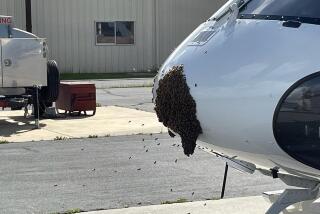An Ultralight Leads Flight of Young Cranes to Deep South
- Share via
NECEDAH, Wis. — Researchers hoping to create a new migratory flight of whooping cranes are leading a group of sandhill cranes on a cross-country trip.
Thirteen juvenile sandhills took off from Necedah National Wildlife Refuge Oct. 3 and flew after a bright yellow ultralight piloted by a man in a crane costume.
Plans call for the planes of Operation Migration to fly 1,250 miles over 15 to 30 days, with rest stops at 36 carefully chosen sites along the way. The sandhills have already completed the Illinois leg of their journey.
If the flocks make it safely to the Chassahowitzka Wildlife Refuge in Florida, a whooping crane flight could be scheduled as early as next year.
The goal is to add a second migratory flock of the endangered whooping cranes, starting from the marshlands of central Wisconsin.
The only migratory flock now in existence travels from nesting grounds in northwestern Canada to a wintering area on the Texas coast. That flock includes 187 whooping cranes--a species that was reduced to only 15 birds in 1941.
A nonmigratory population of whoopers in central Florida includes 77 birds. However, predation from bobcats and alligators has run as high as 14% a year, said Tom Stehn, whooping crane coordinator for the U.S. Fish and Wildlife Service.
That’s one reason whooping cranes weren’t taken on the trial flight this fall.
Instead, their much more plentiful cousins, sandhill cranes, are testing the plan, developed over the last decade by a coalition of private conservation groups and government agencies known as the Whooping Crane Eastern Partnership.
Once in Florida, the flock will go to the coastal wetlands of Chassahowitzka National Wildlife Refuge, which is to be the whoopers’ winter home.
“Basically, we’re looking for three things,” Urbanek said. “Will ultralight migration work for this distance? Will the cranes survive the winter? Will they be wild?”
More to Read
Sign up for Essential California
The most important California stories and recommendations in your inbox every morning.
You may occasionally receive promotional content from the Los Angeles Times.













